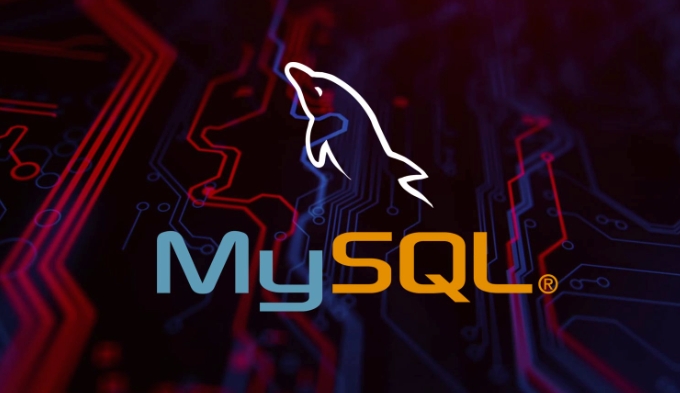The steps to install MySQL server on Linux include confirming the system environment, selecting the installation source, executing installation commands, and initializing settings. First, update the system software package, Ubuntu uses apt update && apt upgrade, CentOS uses yum update; secondly, add official source options, Ubuntu downloads and installs the mysql-apt-config package and updates the source list, and CentOS installs the official rpm package; then executes the installation through apt install mysql-server or yum install mysql-server; then starts the service and sets the boot boot, runs the mysql_secure_installation script for secure configuration; finally pay attention to root login permissions, firewall port opening, and disk space. The entire process needs to be followed by steps and ensure that the network and permissions are configured correctly.

Installing a MySQL server on Linux is not too difficult, but for beginners, they may encounter some confusion in source selection and configuration steps. This article will take you through the installation process step by step and explain some common precautions.

Preparation: Confirm the system and network environment
Before you begin, make sure your Linux system has been updated to the latest status and has access to the Internet normally. Different distributions have slightly different installation methods. Here we take the common Ubuntu and CentOS as examples.

- Update the system package:
- Ubuntu:
sudo apt update && sudo apt upgrade - CentOS:
sudo yum update
- Ubuntu:
In addition, it is recommended to use a user with administrator privileges to perform the installation operation to avoid permission problems.
Installation method selection: use the official source or the default repository?
MySQL is available in the default repository for most Linux distributions, but the version may not be the latest. If you need the latest features or patches, it is recommended to use the APT or YUM source provided by MySQL.

Steps to add official source for Ubuntu users:
- Download the publishing package:
wget https://dev.mysql.com/get/mysql-apt-config_0.8.22-1_all.deb - Install source configuration package:
sudo dpkg -i mysql-apt-config_*_all.deb - Update source list:
sudo apt update
CentOS users can add official sources through the following command:
sudo rpm -Uvh https://dev.mysql.com/get/mysql80-community-release-el7-7.noarch.rpm
After the addition is complete, you can use yum or apt to install the MySQL server.
Installation and Initialization Settings
The installation process itself is very simple, and only one command is required:
- Ubuntu:
sudo apt install mysql-server - CentOS:
sudo yum install mysql-server
After the installation is complete, start the service and set the power-on self-start:
- Start the service:
sudo systemctl start mysqld - Set up startup:
sudo systemctl enable mysqld
At this time, you also need to run a secure initialization script to improve database security:
sudo mysql_secure_installation
This script will let you set the root password, remove anonymous users, disable remote root login, etc. It is recommended to select "Yes" all the way.
Note: Some systems (such as Ubuntu) will automatically create a local root user without password during the installation process. You can enter it with
sudo mysqlwhen logging in for the first time. Remember to modify the password and configure remote access permissions later.
Frequently Asked Questions and Precautions
Several of the most common problems during installation include:
- Unable to connect to MySQL service : Check if the service is started:
systemctl status mysqld - root login failed : it may be because of the password incorrect or the authentication method is incorrect. You can try to use
sudo mysqlto log in and modify your password. - The port is blocked by the firewall : If you want to access MySQL from the outside, the default port is 3306. Make sure that the firewall allows the port to communicate.
- Insufficient disk space or permissions issues : The default data directory of MySQL is
/var/lib/mysql, ensuring that the partition has sufficient space and correct permissions.
If you are installing on a cloud server, don't forget to set security group rules in the console to allow external IP to access the database port.
Basically that's it. Although the whole process seems a bit too many, as long as you operate step by step, there will generally be no major problems.
The above is the detailed content of How to Install MySQL Server on Linux. For more information, please follow other related articles on the PHP Chinese website!

Hot AI Tools

Undress AI Tool
Undress images for free

Undresser.AI Undress
AI-powered app for creating realistic nude photos

AI Clothes Remover
Online AI tool for removing clothes from photos.

Clothoff.io
AI clothes remover

Video Face Swap
Swap faces in any video effortlessly with our completely free AI face swap tool!

Hot Article

Hot Tools

Notepad++7.3.1
Easy-to-use and free code editor

SublimeText3 Chinese version
Chinese version, very easy to use

Zend Studio 13.0.1
Powerful PHP integrated development environment

Dreamweaver CS6
Visual web development tools

SublimeText3 Mac version
God-level code editing software (SublimeText3)
 Connecting to MySQL Database Using the Command Line Client
Jul 07, 2025 am 01:50 AM
Connecting to MySQL Database Using the Command Line Client
Jul 07, 2025 am 01:50 AM
The most direct way to connect to MySQL database is to use the command line client. First enter the mysql-u username -p and enter the password correctly to enter the interactive interface; if you connect to the remote database, you need to add the -h parameter to specify the host address. Secondly, you can directly switch to a specific database or execute SQL files when logging in, such as mysql-u username-p database name or mysql-u username-p database name
 Handling character sets and collations issues in MySQL
Jul 08, 2025 am 02:51 AM
Handling character sets and collations issues in MySQL
Jul 08, 2025 am 02:51 AM
Character set and sorting rules issues are common when cross-platform migration or multi-person development, resulting in garbled code or inconsistent query. There are three core solutions: First, check and unify the character set of database, table, and fields to utf8mb4, view through SHOWCREATEDATABASE/TABLE, and modify it with ALTER statement; second, specify the utf8mb4 character set when the client connects, and set it in connection parameters or execute SETNAMES; third, select the sorting rules reasonably, and recommend using utf8mb4_unicode_ci to ensure the accuracy of comparison and sorting, and specify or modify it through ALTER when building the library and table.
 Implementing Transactions and Understanding ACID Properties in MySQL
Jul 08, 2025 am 02:50 AM
Implementing Transactions and Understanding ACID Properties in MySQL
Jul 08, 2025 am 02:50 AM
MySQL supports transaction processing, and uses the InnoDB storage engine to ensure data consistency and integrity. 1. Transactions are a set of SQL operations, either all succeed or all fail to roll back; 2. ACID attributes include atomicity, consistency, isolation and persistence; 3. The statements that manually control transactions are STARTTRANSACTION, COMMIT and ROLLBACK; 4. The four isolation levels include read not committed, read submitted, repeatable read and serialization; 5. Use transactions correctly to avoid long-term operation, turn off automatic commits, and reasonably handle locks and exceptions. Through these mechanisms, MySQL can achieve high reliability and concurrent control.
 Managing Character Sets and Collations in MySQL
Jul 07, 2025 am 01:41 AM
Managing Character Sets and Collations in MySQL
Jul 07, 2025 am 01:41 AM
The setting of character sets and collation rules in MySQL is crucial, affecting data storage, query efficiency and consistency. First, the character set determines the storable character range, such as utf8mb4 supports Chinese and emojis; the sorting rules control the character comparison method, such as utf8mb4_unicode_ci is case-sensitive, and utf8mb4_bin is binary comparison. Secondly, the character set can be set at multiple levels of server, database, table, and column. It is recommended to use utf8mb4 and utf8mb4_unicode_ci in a unified manner to avoid conflicts. Furthermore, the garbled code problem is often caused by inconsistent character sets of connections, storage or program terminals, and needs to be checked layer by layer and set uniformly. In addition, character sets should be specified when exporting and importing to prevent conversion errors
 Using Common Table Expressions (CTEs) in MySQL 8
Jul 12, 2025 am 02:23 AM
Using Common Table Expressions (CTEs) in MySQL 8
Jul 12, 2025 am 02:23 AM
CTEs are a feature introduced by MySQL8.0 to improve the readability and maintenance of complex queries. 1. CTE is a temporary result set, which is only valid in the current query, has a clear structure, and supports duplicate references; 2. Compared with subqueries, CTE is more readable, reusable and supports recursion; 3. Recursive CTE can process hierarchical data, such as organizational structure, which needs to include initial query and recursion parts; 4. Use suggestions include avoiding abuse, naming specifications, paying attention to performance and debugging methods.
 Strategies for MySQL Query Performance Optimization
Jul 13, 2025 am 01:45 AM
Strategies for MySQL Query Performance Optimization
Jul 13, 2025 am 01:45 AM
MySQL query performance optimization needs to start from the core points, including rational use of indexes, optimization of SQL statements, table structure design and partitioning strategies, and utilization of cache and monitoring tools. 1. Use indexes reasonably: Create indexes on commonly used query fields, avoid full table scanning, pay attention to the combined index order, do not add indexes in low selective fields, and avoid redundant indexes. 2. Optimize SQL queries: Avoid SELECT*, do not use functions in WHERE, reduce subquery nesting, and optimize paging query methods. 3. Table structure design and partitioning: select paradigm or anti-paradigm according to read and write scenarios, select appropriate field types, clean data regularly, and consider horizontal tables to divide tables or partition by time. 4. Utilize cache and monitoring: Use Redis cache to reduce database pressure and enable slow query
 Designing a Robust MySQL Database Backup Strategy
Jul 08, 2025 am 02:45 AM
Designing a Robust MySQL Database Backup Strategy
Jul 08, 2025 am 02:45 AM
To design a reliable MySQL backup solution, 1. First, clarify RTO and RPO indicators, and determine the backup frequency and method based on the acceptable downtime and data loss range of the business; 2. Adopt a hybrid backup strategy, combining logical backup (such as mysqldump), physical backup (such as PerconaXtraBackup) and binary log (binlog), to achieve rapid recovery and minimum data loss; 3. Test the recovery process regularly to ensure the effectiveness of the backup and be familiar with the recovery operations; 4. Pay attention to storage security, including off-site storage, encryption protection, version retention policy and backup task monitoring.
 Optimizing complex JOIN operations in MySQL
Jul 09, 2025 am 01:26 AM
Optimizing complex JOIN operations in MySQL
Jul 09, 2025 am 01:26 AM
TooptimizecomplexJOINoperationsinMySQL,followfourkeysteps:1)EnsureproperindexingonbothsidesofJOINcolumns,especiallyusingcompositeindexesformulti-columnjoinsandavoidinglargeVARCHARindexes;2)ReducedataearlybyfilteringwithWHEREclausesandlimitingselected






